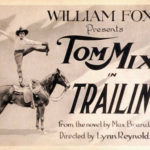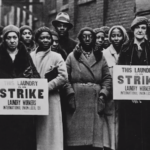Disaster-Porn Shock Horror: Gertie the Galloping Bridge Really Just Lolloped
Now It Can Be Told: 75 years after the infamous collapse of “Galloping Gertie,” the Tacoma Narrows Bridge in Washington State, USA, four physicists have donned moving-image-archivist hats to deduce that famous, much-viewed film footage of the dramatic failure was later greatly speeded up.
n
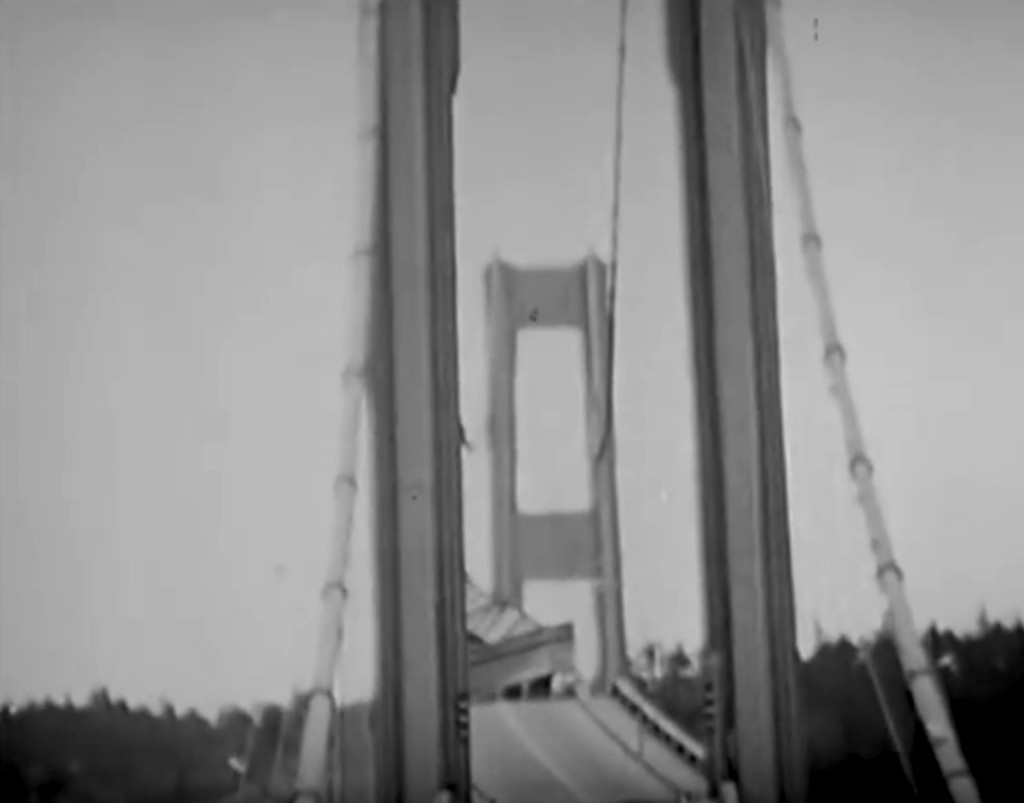 On 7 November 1940, a deep low-pressure zone built 150 miles west of Tatoosh, Washington, and generated high winds that kicked towards Tacoma, a port city about 30 miles to the south of Seattle, in the Northwest corner of the United States. At stations along the coast and inland, meteorologists duly constructed their weather maps with closely spaced isobars that spelled if not trouble, then at least drama.
On 7 November 1940, a deep low-pressure zone built 150 miles west of Tatoosh, Washington, and generated high winds that kicked towards Tacoma, a port city about 30 miles to the south of Seattle, in the Northwest corner of the United States. At stations along the coast and inland, meteorologists duly constructed their weather maps with closely spaced isobars that spelled if not trouble, then at least drama.
 The storm that arrived at the Tacoma Narrows Bridge, which linked the northwestern reaches of Tacoma with the Kitsap Peninsula further west, beyond a passage of Puget Sound, was so forceful that it would eventually wreak havoc far eastward in the Great Lakes region, way past the middle of the country, through the Veterans Day (then still called Armistice Day) national holiday.
The storm that arrived at the Tacoma Narrows Bridge, which linked the northwestern reaches of Tacoma with the Kitsap Peninsula further west, beyond a passage of Puget Sound, was so forceful that it would eventually wreak havoc far eastward in the Great Lakes region, way past the middle of the country, through the Veterans Day (then still called Armistice Day) national holiday.
The Narrows Bridge had already signaled that it might respond badly to such a storm. For months, its long center span had been oscillating disconcertingly, so that the structure had come to be known as “Galloping Gertie.” When the storm of 7 November 1940 arrived, in the form of a god-awful gale, those movements became more than merely dramatic. The third-longest suspension bridge in the world flailed wildly; its 17-inch-thick wire cables of 6,300 strands each pulled clear of their moorings; and the deck broke up and plummeted to the water below.
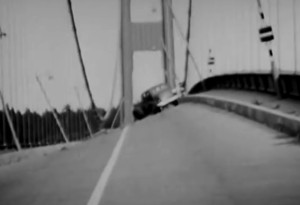
The car that perished from the twisting deck – and Tubby, within. The newspaperman was able to save his pipe.
“Some of the most amazing pictures ever recorded by a newsreel” of the bridge as “it twisted and swayed in its death agony” certainly made for over-the-top news reporting. Among those filmed was a newspaper reporter named Leonard Coatsworth who was unable to complete his crossing of the bridge by car, so had to abandon it, mid-span, with his daughter’s three-legged black cocker spaniel, Tubby, still inside after resisting efforts to save it; mind you, Coatsworth was able to save his pipe.
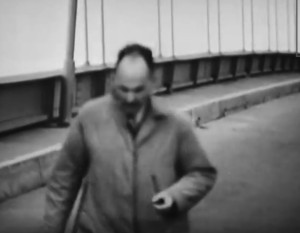 The disaster is especially well known because it was filmed, and footage in various arrangements has been watched innumerable times over the years.
The disaster is especially well known because it was filmed, and footage in various arrangements has been watched innumerable times over the years.
Especially in the Pacific Northwest, generations of residents have savored the images — call it, bridge-collapse porn — over and over. It has long been displayed on Internet platforms like YouTube. There, it has been possible to see the bridge being constructed, and to learn about eminent bridge engineer Leon Moisseiff. Federal and state and experts had approved the plans. The bridge was a state-of-the-art structure.who intentionally deployed a minimum of steel and other materials because he wanted to show how elegantly such a bridge could be built… which construction crew members began to doubt upon noticing an unusual and disconcerting amount of movement, even during construction. Some workmen chewed on lemons to counteract motion sickness. A mile long, the bridge cost a then-impressive $6.5-million and was considered the pride of the region as it neared its completion in 1940.
The films are widely offered as paradigms of how silly humans are when they imagine they can tame The Forces of Nature.
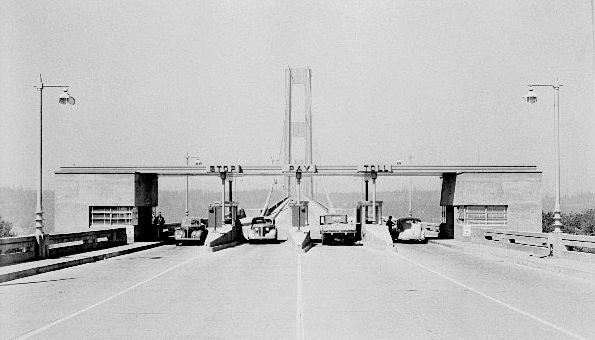
d
Now four physicists from Texas State University at San Marcos have made a startling discovery: When film of the collapse was converted to the video formats that have allowed the events to be so often deployed to show school and university students just How Vain Man Can Be, “the conversion was not always faithful,” they write online in The Physics Teacher (with another version in Physics Today.)
The Texas State U physicists — Don Olson, Joseph Hook, Russell Doescher, and Steven Wolf — write that “physicists over the years have spent a great deal of time and energy studying this event.” Among choice views of the collapse has been one sequence shot from the level of the bridge deck; it shows the deck twisting, almost whipping, up to 45 degrees from the horizontal, a good deal more than the earlier oscillations that had made the bridge something of an attraction for everyday daredevil motorists and pedestrians. A Tacoma News Tribune editorial in August, 1940, observed: “There is no truth in the rumor that part of the Narrows Bridge toll is for the scenic railway effects. The charge is for crossing only and the bounce is free.”
The physicists say it occurred to them, after using the footage over and over in their classroom courses, to check one basic question about the much-viewed video clips of the oscillations and subsequent free fall of the bridge fragments: “Are these scenes sped up, slowed down, or at the correct speed compared to what was observed by the eyewitnesses on Nov. 7, 1940?”
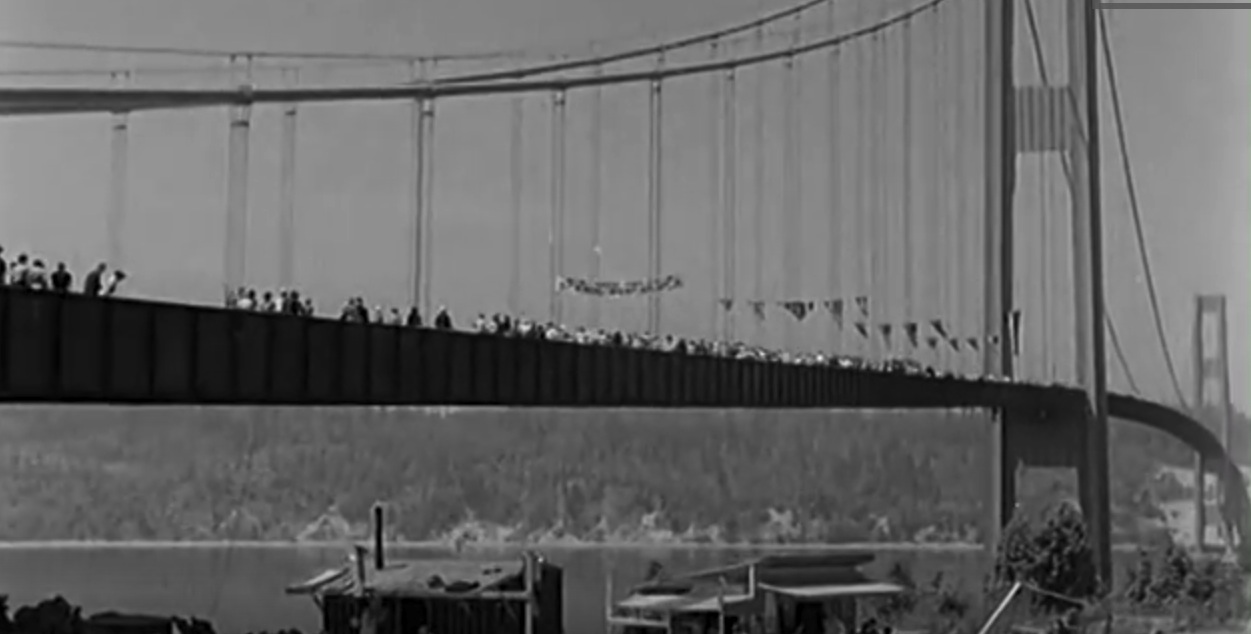 There were eyewitnesses, because even before the storm arrived, it had looked like something was going to give. The Washington State Department of Transportation, any hurt pride long ago healed, has a tell-all on its website, and it relates that in May of 1940, as workmen finished up the bridge’s flooring, engineers noticed what they referred to as “bounce” – waves of vertical movement in the deck.
There were eyewitnesses, because even before the storm arrived, it had looked like something was going to give. The Washington State Department of Transportation, any hurt pride long ago healed, has a tell-all on its website, and it relates that in May of 1940, as workmen finished up the bridge’s flooring, engineers noticed what they referred to as “bounce” – waves of vertical movement in the deck.
 Those commonly measured a few feet in even light winds, but could increase to displacements of 10 feet above and below a level line. During the previous summer, rumors about another bridge, the Bronx-Whitestone Bridge in New York, also designed by Moisseiff, had alerted them that trouble might be brewing in Tacoma, too. Moisseiff admitted to the state engineers that not only the Bronx-Whitestone, but also his Deer Island Bridge, was acting up, though not as much as Gertie. In May 1940 engineers tried to correct her “bounce” by installing hydraulic jacks as shock absorbers at the bridge’s towers.
Those commonly measured a few feet in even light winds, but could increase to displacements of 10 feet above and below a level line. During the previous summer, rumors about another bridge, the Bronx-Whitestone Bridge in New York, also designed by Moisseiff, had alerted them that trouble might be brewing in Tacoma, too. Moisseiff admitted to the state engineers that not only the Bronx-Whitestone, but also his Deer Island Bridge, was acting up, though not as much as Gertie. In May 1940 engineers tried to correct her “bounce” by installing hydraulic jacks as shock absorbers at the bridge’s towers.
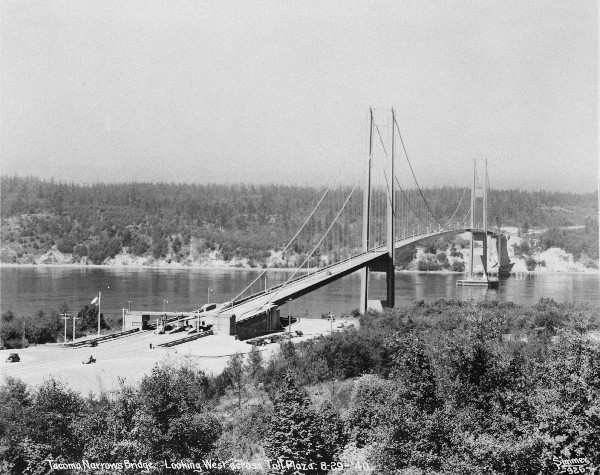 That made no difference. So the Toll Bridge Authority asked F. Bert Farquharson of the University of Washington department of engineering in Seattle to conduct wind-tunnel studies. He and some of his students built a 54-feet-long scale model of the bridge, and made a 1:20 scale model, 8 feet long, of a section of the bridge deck. Already fearing the worst, Farquharson monitored Gertie’s galloping against wind speeds.
That made no difference. So the Toll Bridge Authority asked F. Bert Farquharson of the University of Washington department of engineering in Seattle to conduct wind-tunnel studies. He and some of his students built a 54-feet-long scale model of the bridge, and made a 1:20 scale model, 8 feet long, of a section of the bridge deck. Already fearing the worst, Farquharson monitored Gertie’s galloping against wind speeds.
Then, in October 1940, he and transportation-department engineers tried to jury-rig a solution. About 300 feet from each of the four pillars, they placed anchor cables of just over an inch and a half diameter, while at mid-span they placed diagonal wires between the main cables and the deck.
Before the November storm, workers had to make running repairs on snapped cables, but engineers were assured in their solution after the bridge withstood winds of more than 50 miles per hour. Still, Farquharson noted that if the bridge were to twist, under certain conditions, that could “be the end of the bridge.” He said part of the problem was that the bridge’s girders were solid, and would better secure the bridge if they allowed wind to whistle through; he recommended: cut holes in them, or deflect wind around them with sections of curved steel “fairings.”
On 6 November, the day before the collapse, as state officials drafted a contract for the installation of those wind deflectors, the bridge’s project engineer Clark Eldridge met with Burt Farquharson and an engineer working for the Public Works Agency which was providing funding under President Roosevelt’s “New Deal” for public major construction projects, to plot a course of action for streamlining the south side of the center span. Even on the morning of the collapse, Eldridge began sketching and pricing the repairs. The plan called for a rapid retrofit: Within 10 days, the deflectors would protect against southerlies; within two weeks, deflectors would fully protect the south side of the center span and within 45 days, both sides of the entire bridge.
What, then, have the four physicists found? That some footage had been speeded up — the footage taken from the bridge deck — but only inadvertently.
n
The four physicists say in The Physics Teacher that their “most surprising result” was that the commonly available teaching tools that include on the much-ballihooed footage, whether on videodisc, VHS, or DVD, provide “a mistaken impression of the bridge’s motions” because they depict “rapid torsional oscillations” — twisting motions — of 18 cycles per minute, and that means the original images were, somewhere along the way, “significantly sped up.”
Indeed, write the physicists, the images are a full 50 per cent faster than the actual event, where the twisting occurred at 12 cycles per minute, which they poetically characterize as “more majestic and lower frequency oscillations” that eyewitnesses saw on 7 November, 75 years ago, although that isn’t how the few people actually on the bridge deck that day experienced them.
Their findings did exonerate some of the sequences seen in the video packages used commonly by educators, specifically those that depict the bridge deck falling to the water.
To make their measurements, they worked with the same film sequences used by video producers over the decades: 16mm footage taken by four people. Those were bridge official Walter F. Miles, Barney Elliott and T. Harbine Monroe from a camera shop in Tacoma, and F. Burt Farquharson of the University of Washington. Those eyewitnesses had cameras that operated at 12 frames per second (or slower, to conserve film), 16fps (silent speed), 24fps (sound speed), or 36fps and higher (slow motion).
In the moments before 600 feet of roadway broke away on that 7 November, Burt Farquharson noticed that the bridge’s vertical oscillation suddenly changed to a twisting motion, and he handily had a stopwatch so was able to gauge that the torsion was happening at the rate of 12 cycles per minute. When the detached roadway fell into the water, T. Harbine Monroe was among photographers to film parts of the process. He captured part of the roadway’s plummet, which took less than 10 minutes from detachment from the bridge to submersion in the Sound.
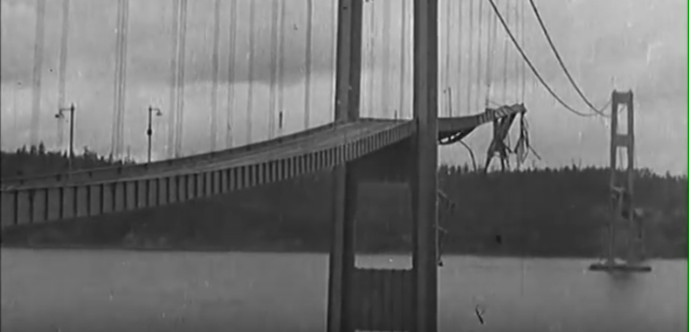
n
The images that have come down to common viewing today have threaded their way through various education-video productions. Say the four physicists: “Most physics teachers and students from the 1960s, 1970s, and even into the 1980s have a vivid recollection of the flickering images cast by the film loop projector, as the bridge twisted and collapsed.”
The conversions began in 1961–1963, when Franklin Miller transferred original 16mm footage of the collapse to 8mm format and created a series of so-called “physics single-concept films.” Those went out to schools and colleges in cartridges that played at 18 fps in Technicolor 8mm film loop projectors.
From 1979 to 1982, Robert Fuller, Dean Zollman, and Thomas Campbell produced a videodisc containing Miller’s film and additional archival footage. Write the four physicists: “Video formats (videodiscs, VHS, and DVD) operate near 30 fps and can employ an interlaced scan that generates a complete video frame in two passes, the first pass displaying the odd-numbered horizontal scan lines and the second pass filling in the gaps by displaying the even-numbered lines.”
Using the video products commonly distributed for classroom use, the authors deduced time intervals for events depicted. They dissected the action, frame by frame, and gauged the length of events based on that 30 fps frame rate. That gave them a way to compare the rate of oscillations – 18 per minute – against measurements by observers at the time of the disaster. The rate of 18 was “in stark contrast to Farquharson’s stopwatch observations of the last oscillations on Nov. 7, 1940, when he measured an actual frequency of 12 cycles per minute.”
The authors also deduced how this could have occurred: it was function of the transfer technique used, telecine. They write: “The technicians making the conversion from film to videodisc assumed that all of the 16mm cameras were running at 24 fps, and they knew that videodisc players would operate at 30 fps. Therefore, every four film frames were converted to five interlaced video frames. … When we looked frame by frame at the Tacoma videodisc, we indeed observed three clear frames followed by two ‘fuzzy’ hybrid frames, in a repeated pattern.” They checked with Zollman, who told them that indeed that was the conversion process he and his colleagues had used.
They found some other discrepancies, such as that in the now-superceded Franklin Miller 8mm film loop, the bridge scenes are off-speed: in it, the twisting was sped up by a factor of 18/16 due to conversion from 16mm to the 18 frames per second of Technicolor projectors, while the collapse to the water was considerably slowed, by a factor of 18/24.
But their key finding related to the still-used video products (those on videodisc, VHS, or DVD): because the telecine conversion was done by assuming that all the 16mm cameras were running at the sound speed of 24 fps, viewers of the modern video formats see the torsional oscillations significantly sped up (18 cycles per minute), compared to the lower frequency (12 cycles per minute) observed by eyewitnesses on or near the actual bridge on Nov. 7, 1940.
By the by, the four physicists reiterate that, contrary to what most physics teachers still tell their students, the bridge collapse was not a matter of “torsional oscillation by resonance.” They asked: “Was the wind on that day blowing steadily at a special speed that excited the torsional oscillations by resonance? Or did the wind exceed a critical speed such that “self-excitation” could occur?” Those questions were prompted by a history in scientific literature of theories of the cause of the Narrows bridge collapse. That popular theory, long shown to be hogwash, holds that a “resonance phenomenon in the amplitude” had operated, as a function of wind velocity, to cause the dreadful oscillations.
Among colleagues who have demonstrated the falsehood of that theory, explain the four physicists, are Daniel Green and William Unruh, who “used computational fluid dynamics to show how a constant strong wind could produce a large amplitude vibration via a positive feedback instability (negative damping) caused by the development of large-scale vortices above and below the deck of the bridge.” So, “aerodynamic self-excitation” had occurred.
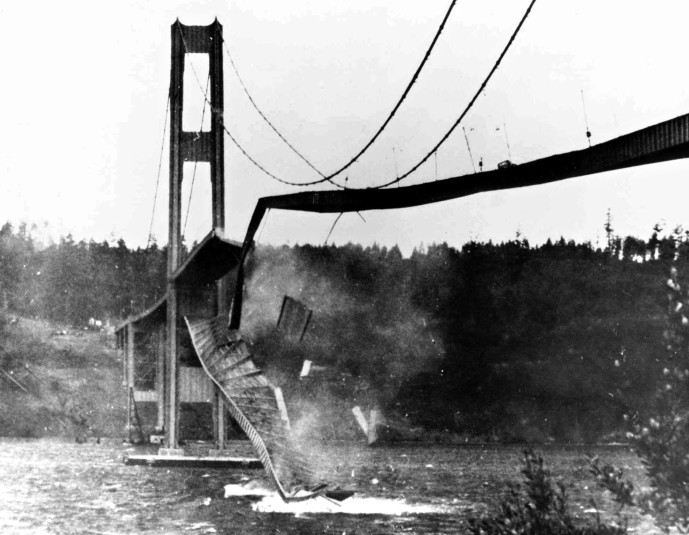
James Bashford, Tacoma News Tribune, 1940
In their articles, the four physicists also analyzed previous estimates of how far the bridge deck fell — 210 feet (64 metres). They make the calculation by reference to their dissections of the film footage, and if you hold a degree in a mathematical science, and are unintimidated by discussions of such concepts as “cubic splines” and equations with lots of squiggly mathematical thingies in them, you can read all about that, in their papers.
Long story short, however, is that the physicists “conclude that while viewers of educational packages of the bridge collapse see it fall to the water at correct speed, they get an exaggerated picture of the bridge deck’s break-up.
Now anyone who has ever watched the film clip and exclaimed, “Crikey, how could it have ripped apart like that,” and who has, even, doubted if only in the back of his or her mind that the collapse could really happen quite so dramatically, can read in The Physics Teacher that it indeed did not disintegrate quite as quickly as it has seemed to do.
Two footnotes: The Washington State Toll Bridge Authority reimbursed Leonard Coatsworth $450 for the loss of his car, and $364.40 for the loss of its “contents.” As for the bridge’s designer, Leon Moisseiff, he died a few years later, and although he had led or assisted in the design of the Manhattan Bridge, the Golden Gate Bridge, and others, it can safely be induced that it is Galloping Gertie who will long dance on his grave. In American Scientist, at the time of the collapse, civil engineer David Steinman commented that he had offered findings about the bridge’s “undulatory behavior” to bridge engineers, but been rebuffed: “The amazing feature of the catastrophe was the confidence of the bridge authorities in the safety of the structure and their failure to apply adequate corrective measures before opening the bridge to traffic. On the morning of the failure, after the oscillations had become alarming, the engineer in charge finally decided that diagonal stays were desirable; he rushed to the telephone to order the wire ropes for early installation but when he returned to the bridge, the span was gone.”
— Peter Monaghan
Previous Post: Ongoing Greatness and What Brings You to Maine?
Next Post: Owen Land's Strange, Expansive Film World

